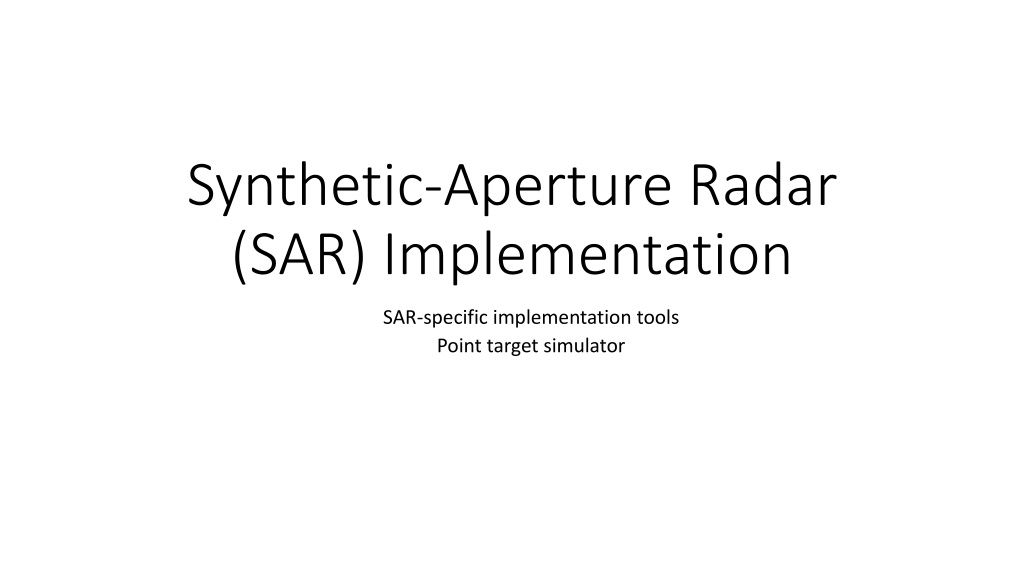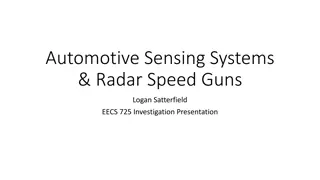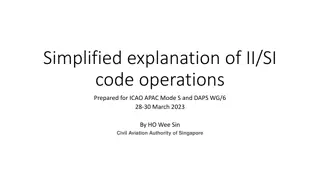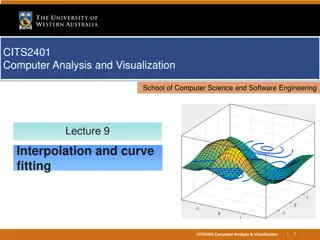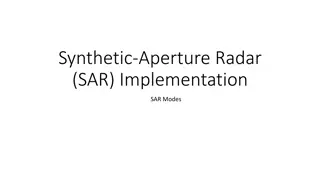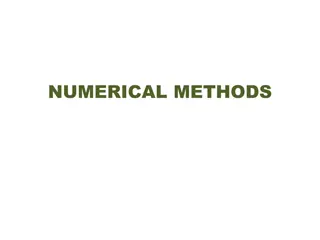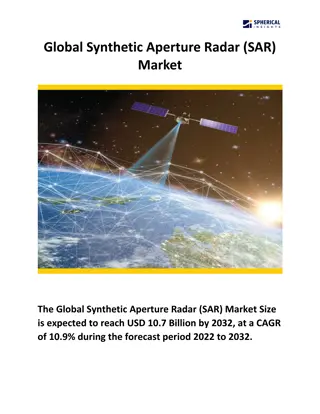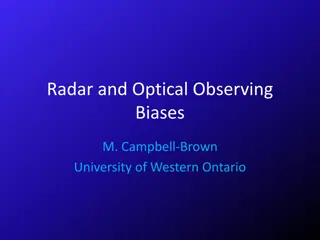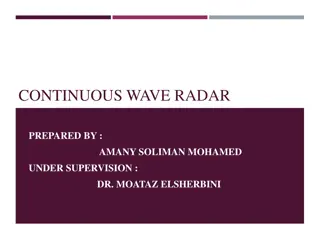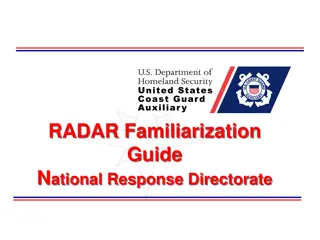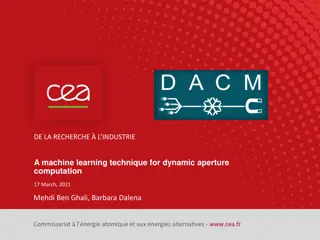Understanding Interpolation Techniques for Synthetic Aperture Radar (SAR) Implementation
Dive into the world of Synthetic Aperture Radar (SAR) implementation tools and techniques, including resampling methods, interpolation of band-limited signals, and the analysis of SAR-specific algorithms like range Doppler and chirp scaling. Explore how resampling algorithms enable non-uniform sampling of data and how band-limited signals can be interpolated for applications such as signal correction and image co-registration in SAR technology.
Download Presentation

Please find below an Image/Link to download the presentation.
The content on the website is provided AS IS for your information and personal use only. It may not be sold, licensed, or shared on other websites without obtaining consent from the author. Download presentation by click this link. If you encounter any issues during the download, it is possible that the publisher has removed the file from their server.
E N D
Presentation Transcript
Synthetic-Aperture Radar (SAR) Implementation SAR-specific implementation tools Point target simulator
Announcements Homework posted this evening. Due next Tuesday at the beginning of class. Please start working on homework before Thursday so our class period and workshop time will be productive. Workshop: Each Thursday 4-8PM May add an additional time. If you cannot make this time or you find it is not enough time, please email me and I will try to coordinate an additional time.
Agenda Week 1 Tools Re-sampling methods Pulse compression Signal Model (point target simulator and matched filter) Array Processing view of SAR Analytical forms Week 2 Analytical forms continued SAR matched filter approximations Range Doppler Algorithm, Chirp Scaling Algorithm, and F-k Migration
Resampling Two algorithms or tools that we will need: Non-uniform sampling of uniformly sampled data Sampling of non-uniformly sampled data How can we do this?
Interpolation of Band Limited Signals We are specifically interested in SAMPLED Band Limited Signals where we want to know a value between currently known samples. Applications Range cell migration correction in the RDA Stolt interpolation in FK migration Time domain correlation to find the matched filter at the specific data samples that are collected. Resample SAR images as part of a co-registration process
Interpolation of Band Limited Signals: Quick thought experiment Pretend you are only allowed to know the value of a continuous signal at one point (e.g. where you will sample it) If you could first apply the Fourier time shift property to the signal with a time shift of ? that you controlled, then you could find the value at any other point offset by ? from the sampling point: ? ? ? ?2?? ???2????? ? ? ? = This is one way to think about band-limited interpolation we delay the signal and then re-sample it.
Interpolation of Band Limited Signals: Sampled signal Multiply Convolution Time Frequency Impulse train multiplied with continuous time signal Impulse train convolved with band limited signal
Interpolation of Band Limited Signals: Reconstruct and delay Multiply Convolution Reconstruction filter returns signal to its original form The reconstructed and delayed signal is just convolution with a delayed sinc. sinc(t-Dt) Multiply Complex exponential time shifts the original signal Multiply in the frequency domain with bandwidth limited complex exponential
Interpolation of Band Limited Signals: Resample this reconstructed and delayed signal If we resample this convolution with a delayed sinc , this is: ? ? ? ? ? ?? ? ? ? ? ?? ???? ?? ?= Simplifying, we find that it is just convolution with the sampled and delayed sinc function: ?= ?= ? ? ? ? ???? ? ?= ?=
Interpolation of Band Limited Signals: Non-uniform sampled data The sinc kernel can be extended to interpolating non-uniformly sampled data. Since the sinc function is analytical, we just need to sample it at the point locations that we have available to us. This can be used to re-sample data from platforms with varying velocity. If the PRF is constant, the azimuth sampling will be variable in space. By resampling at uniform positions, we can make use of FFT based algorithms.
Pulse Compression Output: Derive response for boxcar weighted chirp Transmit signal is: ? ? ??? ????2 s ? = ???? The matched filter impulse response is the transmit signal time reversed and conjugated: ? ? ??? ????2 h ? = ???? Convolution is then: ???? ? ? ? ? ? ??? ????2???? ??? ??? ? ?2?? Matched Filter Transmit Signal
Pulse Compression Output : Derive response for boxcar weighted chirps Convolution ? ? ? ? ? ??? ????2???? ??? ??? ? ?2?? ???? This is two rect functions sweeping past each other. One method is to break the integral into two parts. The first part handles t < 0 and the second part handles t >= 0: ?+? 2??? ????2??? ??? ? ?2?? ? + ? ? 2 ???? ? 2 ? 2 ? ? ? 2 ??? ????2??? ??? ? ?2?? + ???? ? ? 2 Gray boxes show min/max positions of rect(t-t) for first integral. 1. Values of t that give nonzero response range from -T to 0 - Handled by rect in from of integral. 2. Integration is from -T/2 to t+T/2. - Handled by integration limits. t 0 t -T/2 T/2 -T t+T/2
Pulse Compression Output : Derive response for boxcar weighted chirps Manipulating complex exponentials gives: ?+? ? 2 ? + ? ? ? ? 2 ? 2 2??? ?2???? ?? + ???? ??? ????2 ???? ??? ?2???? ?? ? ? ? 2 2 Starting with the first integral: ? + ? ? 2 ?2?????? ?2??? ? +? 1 ??? ?2???? ??? ????2???? 2 2 Combine exponentials: ? + ? ? 2 ??? ???? ? + ? ??? ???? ? + ? ?2??? ????
Pulse Compression Output : Derive response for boxcar weighted chirps Noting that the numerator is an expression minus its conjugate, as in A+jB (A- jB) = 2jB and noting that the imaginary part of the complex exponential is the sine of the argument: ? + ? 2 ? Cancelling and adding in some terms: ? + ? 2 ? Noting the final term is a sinc function: ? + ? 2 ? ?2??? ??? ? + ? ?2??? ???? ??? ??? ? + ? ??? ? + ? ? + ? ???? ? + ? ???? ???? ?? ? + ?
Pulse Compression Output : Derive response for boxcar weighted chirps Doing the same for the second integral: ? ? ? 2 ?2?????? ?2???? 1 ??? ?2??? ? ? ??? ????2???? 2 2 Combining complex exponentials: ? ? Following the same steps as before, the second integral becomes: ? 2 1 ???? ?2?????? ???? ? ? ??? ???? ? ? ? ? ? 2 ? ? ???? ???? ?? ? ?
Pulse Compression Output: Low Sidelobe Applications Importance of Tukey windowing for small time bandwidth products where very low sidelobes are required and for lessening power amplifier distortion of the signal
Pulse Compression Output: Low Sidelobe Applications Importance of Tukey windowing for small time bandwidth products where very low sidelobes are required and for lessening power amplifier distortion of the signal
Signal Model and Array Processing
System Geometry and Signal Model Desired transmit signal: s ? = rect ?/???cos 2?fc? + ???2 Desired transmit signal written in terms of IQ modulation: s ? = sI? cos 2?fc? ??? sin 2?fc? The complex baseband signal (using IQ demodulation) is: sBB? = sI? + ???? = LPF s ? cos 2?fc? + ?? ? sin 2?fc? sBB? = rect ?/??? cos ???2+ ???? ???2
System Geometry and Signal Model The delayed by ?? transmit signal is: s ? ?d = rect( ? ?d/Tpd)cos 2?fc? ?d + ?? ? ?? 2 The delayed complex baseband signal from a delayed and demodulated transmit signal is: sBB? ?d ? ?d ??? + ???? ?? ? ?d 2 = rect cos ?? ? ?d 2exp ?2?????
System Geometry and Signal Model: RF signal from Baseband (IQ modulation) ? cos ???2cos 2?fc? ? ? = rect Tpd ? sin ???2sin 2?fc? -rect Tpd ? ? =1 ???2+ cos 2?fc? + ???2 ? cos 2?fc? + ???2+ cos 2?fc? ???2 cos( 2rect 2?fc? Tpd ) ? cos 2?fc? + ???2 ? ? = rect Tpd
System Geometry and Signal Model: Baseband from RF signal (IQ demodulation) ? cos 2?fc? + ???2cos 2?fc? =1 2LPF rect =1 2rect Tpd sI? = LPF rect Tpd ? cos ???2+ cos 4???? + ???2 Tpd cos ???2 ? ? cos 2?fc? + ???2sin 2?fc? =1 2LPF rect =1 2rect Tpd s?? = LPF rect Tpd ? sin ???2+ sin 4???? + ???2 Tpd sin ???2 ? s??? =1 ? exp ????2 2rect Tpd
System Geometry and Signal Model: Baseband from delayed delayed RF signal (IQ demodulation) ? ?? Tpd 2cos 2?fc? sI? = LPF rect cos 2?fc? ?? + ?? ? ?? ? ?? Tpd ? ?? Tpd =1 2+ cos sum 2LPF rect =1 2rect cos 2?????+ ?? ? ?? 2 cos 2?????+ ?? ? ?? ? ?? Tpd 2sin 2?fc? s?? = LPF rect cos 2?fc? ?? + ?? ? ?? ? ?? Tpd ? ?? Tpd =1 2+ sin diff 2LPF rect =1 2rect sin 2?????+ ?? ? ?? 2 sin 2?????+ ?? ? ?? s??? =1 ? ?? Tpd 2exp ?2????? 2rect exp ??? ? ??
System Geometry and Signal Model: Generalized signal ? ? cos 2?fc? + ? ? : Baseband from RF signal (IQ demodulation) sI? = LPF ? ? cos 2?fc? + ? ? =1 2LPF ? ? cos ? ? =1 2? ? cos ? ? s?? = LPF ? ? cos 2?fc? + ? ? =1 2LPF ? ? sin ? ? =1 2? ? sin ? ? s??? =1 cos 2?fc? + cos 4???? + ? ? sin 2?fc? sin 4???? + ? ? 2? ? exp ?? ?
System Geometry and Signal Model: Generalized delayed signal ? ? ??cos 2?fc? ?? + ? ? ?? Baseband from RF signal (IQ demodulation) : sI? = LPF ? ? ??cos 2?fc? ?? + ? ? ?? =1 2LPF ? ? ?? cos 2?fc??+ ? ? ?? =1 2? ? ??cos 2?fc??+ ? ? ?? s?? = LPF ? ? ??cos 2?fc? ?? + ? ? ?? =1 2LPF ? ? ?? sin 2?fc??+ ? ? ?? =1 2? ? ??sin 2?fc??+ ? ? ?? s??? =1 cos 2?fc? + cos sum sin 2?fc? + sin diff 2? ? ?? exp ?? ? ?? exp j2?fc??
System Geometry and Signal Model: For array processing and narrowband assumption and InSAR For narrowband array processing: We assume envelope and phase functions are slowly varying relative to the time delays between array elements. ? ? ?? ? ? and ? ? ?? = ? ? s??? =1 exp j2?fc?? s??? 1 exp j2?fc?? Time delays can be modeled by multiplication by an exponential! We make the same assumption after two SAR images have been coregistered: coregistration aligns the baseband signals leaving only the carrier phase! Spatial and temporal decorrelation mean that ? ? and ? ? undergo more than just a time shift and instead the functions themselves change between SAR data collections. 2? ? ?? exp ?? ? ?? 2? ? exp ?? ?
Doppler Frequency ???? is the delay caused by changes in range where ?? is slow time ??,???????= ? is caused by the Doppler shift which shifts the frequency of the received chirp which then results in a time delay shift when matched filtered t_{d,doppler} is very small and can be ignored in many circumstances. SAR literature confusingly refers to slow time frequency domain as the Doppler domain even though it is not and Doppler shifts have nothing to do with SAR processing and SAR resolution. At best the (actual) Doppler does not matter at all, at worst it is a nuisance that must be compensated for. ?????
Doppler Frequency Think of SAR as a regular array (that is exactly what it is). The fact that the array element is moving during the fast time measurement is due to necessity (we can't stop the airplane every few centimeters to take a stationary measurement) and not because there is some advantage to having a Doppler shift on the fast time signal. The fact that the Doppler frequency happens to be equal to the wavenumber frequency mapped to the slow time frequency domain is purely a coincidental relationship that does not actually have any bearing on Nyquist sampling the spatial signal. For example, if we were to take the spatial measurements in a stepped manner (zero velocity during measurements), SAR processing still works fine (better actually) and the Doppler shift in fast time is zero. So even though the equations will work out for a constant velocity linear path if you use the Doppler frequency and will appear to be giving you a Nyquist sampled result, it is really misleading to think of SAR in terms of Doppler.
